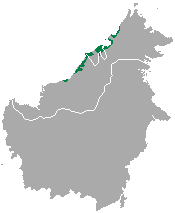汶莱马来语
汶莱马来语(汶莱马来语:Bahasa Melayu Brunei;爪夷文: بهاس ملايو بروني)是汶莱使用最广泛的语言,也是砂拉越和沙巴部分地区的通用语(如纳闽、林梦、老越、实必丹等地)[2][3]。虽然标准马来语被推广为汶莱的官方国家语言,但汶莱马来语在社会上占主导地位,并且目前存在取代汶莱境内其他少数民族语言如杜顺语及都东语的趋势[4][5],亦因此汶莱存在双层语言的现象,其中汶莱马来语常用于日常交流,与上述地方语言和各种马来语克里奥尔语共存,而正式场合中则使用标准马来语。汶莱马来语与标准马来语具显著相似度,几乎可以相互理解[6],与标准马来语有大约 84% 同源[7]。
| 汶莱马来语 | |
|---|---|
| Brunei Malay | |
| Bahasa Melayu Brunei بهاس ملايو بروني | |
| 母语国家和地区 | |
| 族群 | 汶莱马来人、卡达央人 |
母语使用人数 | 320,000 (2013–2019)e25 |
| 语系 | 南岛语系
|
| 方言 | 汶莱马来方言 (main)
甘榜亚逸方言
卡达央方言
|
| 文字 | 拉丁字母 阿拉伯字母 (爪夷文) 谚文 (有限使用) |
| 语言代码 | |
| ISO 639-3 | kxd |
| Glottolog | brun1242[1] |
 使用汶莱马来语的地区 | |
词汇
编辑| 汶莱马来语 | 标准马来语 | 词义 |
|---|---|---|
| Aku/ku | 第一人称单数 | |
| Saya | ||
| Peramba | Patik | 与皇室成员交谈时的第一人称单数 |
| Awak | 第二人称单数 | |
| Kau | ||
| Ko | ||
| Awda | Anda | 来自(si) awang及(si) dayang,其用法与马来语单词anda一致 |
| Kamu | 第二人称复数 | |
| Ia | Dia | 第三人称单数 |
| Kitani | Kita | 第一人称复数(含听话者) |
| Kita | 可以像kitani或者biskita一样使用 | |
| Si awang | Beliau | 男性第三人称单数 |
| Si dayang | 女性第三人称单数 | |
| Biskita | Kita | 称呼年长听众时使用的第一人称复数 |
| Cinta | Tercinta | 称呼所爱的人 |
| Ani | Ini | 这 |
| Atu | Itu | 那 |
| (Di) mana? | (在)哪里? | |
| Ke mana? | 去哪里? | |
| Lelaki | 男人 | |
| Laki-laki | ||
| Perempuan | 女人 | |
| Bini-bini[a] | ||
| Budiman | Tuan/Encik | 一位绅士 |
| Kebawah Duli | Baginda | 陛下 |
| Awu | 是 | |
| Ya | ||
| Inda | 否 | |
| Tidak | ||
| kabat | Tutup | 关闭(门等) |
| Makan | 吃 | |
| Suka | 喜欢 | |
| Cali | Lawak | 有趣(形容词),源自查理卓别林 |
| Siuk | Syok | cf. 马来西亚:syok, 新加坡:shiok |
| Lakas | Lekas | 快、快点(亦用作感叹词) |
| Karang | Nanti | 稍后,不久之后 |
| Tarus | Terus | 立即地 |
| Manada | Mana ada | 用作处于否认状态时的术语(如“不可能”、“不行”) |
| Baiktah | Lebih baik | 不妨... |
| Orang putih | Orang putih; Mat salleh | 一般指西方白人 |
| Kaling | 指具有印度人血统的汶莱人。(通常被认为是贬义词)[8] | |
- ^ 在马来语中,Bini-bini专门用于汶莱,指称女性。在印尼、马来西亚和新加坡,该词被用作非正式的方式来称呼一个人的妻子或一群已婚妇女。
参考文献
编辑- ^ Hammarström, Harald; Forkel, Robert; Haspelmath, Martin; Bank, Sebastian (编). Brunei. Glottolog 2.7. Jena: Max Planck Institute for the Science of Human History. 2016.
- ^ Clynes, A. (2014). Brunei Malay: An Overview. In P. Sercombe, M. Boutin, & A. Clynes (Eds.), Advances in Research on Linguistic and Cultural Practices in Borneo (pp. 153–200). Phillips, ME: Borneo Research Council. Pre-publication draft available at http://fass.ubd.edu.bn/staff/docs/AC/Clynes-Brunei-Malay.pdf
- ^ Deterding, David & Athirah, Ishamina. (2017). Brunei Malay. Journal of the International Phonetic Association, 47(1), 99–108. doi:10.1017/S0025100316000189
- ^ McLellan, J., Noor Azam Haji-Othman, & Deterding, D. (2016). The language situation in Brunei Darussalam. In Noor Azam Haji-Othman, J. McLellan, & D. Deterding (Eds.), The use and status of language in Brunei Darussalam: A kingdom of unexpected linguistic diversity (pp. 9–16). Singapore: Springer.
- ^ Noor Azam Haji-Othman & Siti Ajeerah Najib (2016). The state of indigenous languages in Brunei. In Noor Azam Haji-Othman, J. McLellan, & D. Deterding (Eds.), The use and status of language in Brunei Darussalam: A kingdom of unexpected linguistic diversity (pp. 17–28). Singapore: Springer.
- ^ A. Clynes and D. Deterding. Standard Malay (Brunei). Journal of the International Phonetic Association. 2011, 41 (2): 259–68. doi:10.1017/S002510031100017X . 已忽略未知参数
|df=(帮助) - ^ P.W. Martin and G. Poedjosoedarmo (1996). An overview of the language situation in Brunei Darussalam. In P.W. Martin, C. Ozog & G. Poedjosoedarmo (Eds.), Language use & language change in Brunei Darussalam (pp. 1–23). Athens, Ohio: Ohio University Center for International Studies. p. 7.
- ^ Najib Noorashid (2016). The 'K' word referring to Indians in Brunei. Paper presented at the Brunei-Malaysia 2016 Forum, Universiti Brunei Darussalam, 16–17 November 2016.
阅读书目
编辑- Royal Geographical Society (Great Britain). On Northern Borneo. Proceedings of the Royal Geographical Society XVI. Edward Stanford. 1872: 171–187. [1] [2] 互联网档案馆的存档,存档日期2018-10-01. [3] [4] [5]
- Haynes, A. S. “A List of Brunei-Malay words.” JSBRAS 34 ( July 1900): 39—48. [7]
- Hose, Charles. No. 3. "A Journey up the Baram River to Mount Dulit and the Highlands of Borneo". The Geographical Journal. No. 3. VOL. I. (March, 1893)
- MacBryan, G.T. 1922. Additions to a vocabulary of Brunei-Malay. JSBRAS. 86:376–377. [8]
- Marshall, H.B. and Moulton, J.C. 1921, "A vocabulary of Brunei Malay", in Journal of the Straits Branch, Royal Asiatic Society. [9] [10] [11]
- Marshall, H.B. 1921. A vocabulary of Brunei Malay. JSBRAS. 83:45–74.
- Ray, Sidney H. 1913. The Languages of Borneo. The Sarawak Museum Journal. 1,4:1–196.
- Roth, Henry Ling. 1896. The Natives of Sarawak and British North Borneo. 2 vols. London: Truslove and Hanson. Rep. 1980. Malaysia: University of Malaya Press. [12] VOL I. [13] VOL II. VOL II. [14]
- Marshall, H. B., A Vocabulary of Brunei Malay, Journal of the Straits Branch of the Royal Asiatic Society, 1921, (83): 45–74, JSTOR 41561363
- Soderberg, Craig D. Kedayan. Illustrations of the IPA. Journal of the International Phonetic Association. 2006年, 44 (2): 201–205. doi:10.1017/S0025100314000061 无效
|doi-access=表达式错误:无法识别标点符号“年”。(帮助), with supplementary sound recordings.
- Deterding, David and Athirah, Ishamina. Brunei Malay. Illustrations of the IPA. Journal of the International Phonetic Association. 2013年, 47 (1): 108–99. doi:10.1017/S0025100316000189 无效
|doi-access=表达式错误:无法识别标点符号“年”。(帮助), with supplementary sound recordings.